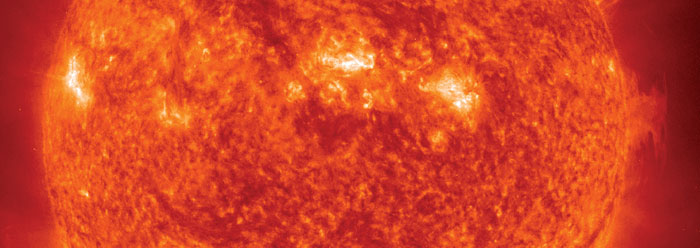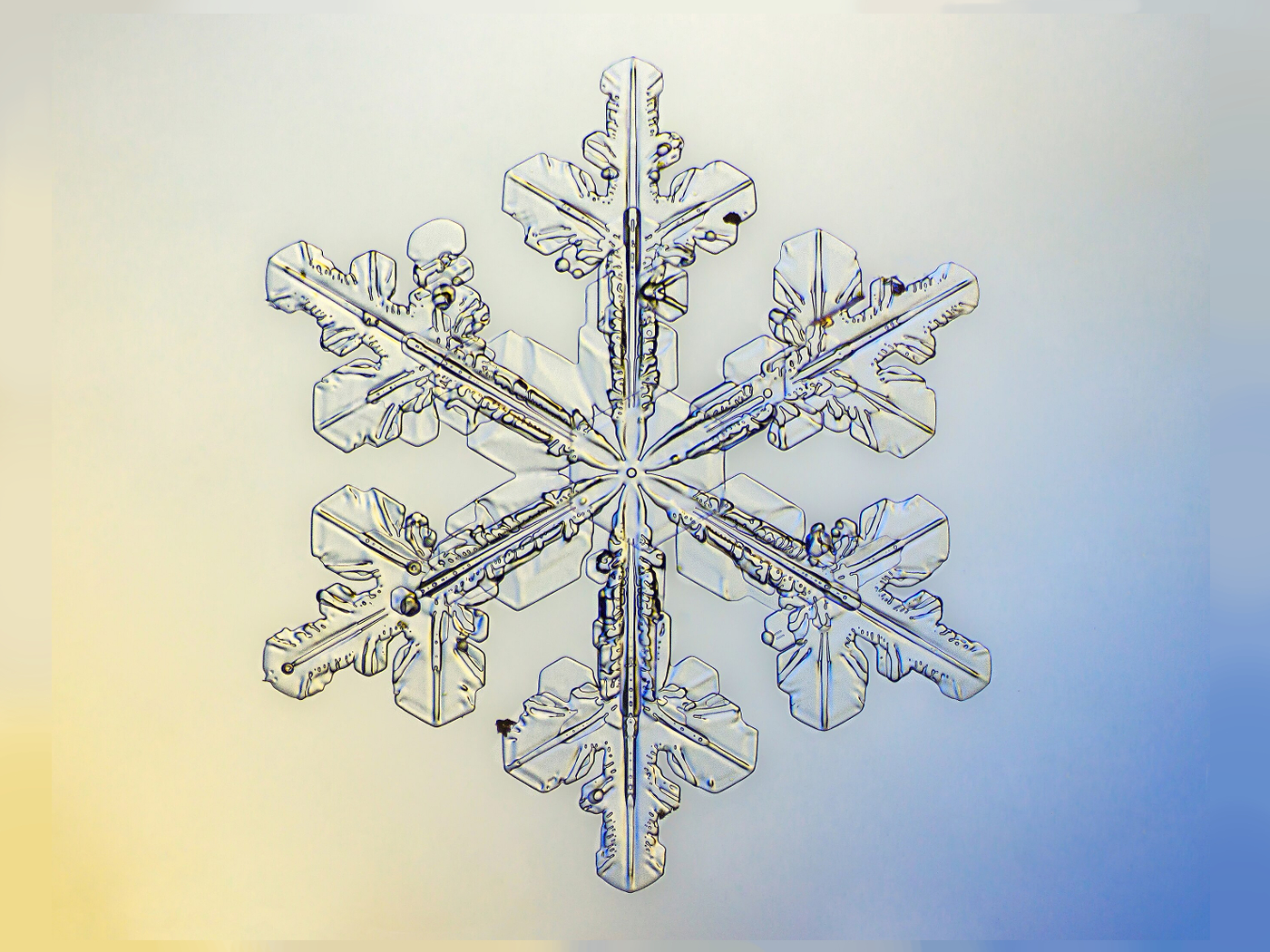Then God made...the greater light to rule the day. (Genesis 1:16)
At the heart of our solar system is the sun, a stable hydrogen “bomb” that gives off more energy every second than a billion major cities would use in an entire year. The sun is remarkable in its complexity and power. When we examine the science of the sun, we find that it confirms biblical creation.
The Creation and Purpose of the Sun
The sun and other luminaries in the sky were created on the fourth day of the creation week. Genesis informs us that the purpose for these lights in the sky is (1) to separate day from night, (2) to help us mark the passage of time, and (3) to give light upon the earth (Genesis 1:14-15). A fourth purpose is revealed elsewhere in Scripture—to declare God’s glory (Psalm 19:1-6).
These four purposes are given to the luminaries in general. But two of these purposes are accomplished almost entirely by the sun. The sun alone separates day from night. And although all the luminaries give light upon the earth, their contribution is insignificant in comparison to the brilliance of sunlight. The sun and moon are both described as “great” lights in Genesis, perhaps because they appear far brighter than any other lights and also because they appear as large disks, whereas all the other luminaries are visible as points with no discernible size. The sun is the greater of these two, being far brighter than the moon and having its own internal power source. The moon is the lesser great light, being far dimmer than the sun and receiving its power to illuminate from the sun itself. The moon shines only by reflected sunlight.
A fifth purpose of these two heavenly lights is given in Genesis 1:16—to “govern” the day and the night. The Hebrew word rendered as “govern” or “rule” means to have power or dominion. The sun can be said to have “power” over the day because it defines the day and overpowers all other luminaries during the day. The moon “governs” the night by outshining all other nighttime luminaries. The moon is not always visible at night, and the stars can “rule” the night in the moon’s absence (Psalm 136:9). Because they “govern” day and night, the luminaries quickly became a symbol of government. Just think of how many countries have the sun, moon, or stars on their nations’ flags. The Bible portrays the family of Israel using the symbols of the sun, moon, and stars (Genesis 37:9), a symbol that recurs throughout Scripture (e.g., Revelation 12:1).
Curiously, God provided a temporary light source to separate day from night for the first three days.1 Why was the creation of the sun displaced until day four? Also, why doesn’t the Genesis account mention the sun or the moon by name? They are only referred to descriptively as the “greater light” to govern the day and the “lesser light” to govern the night. (We do know that this refers to the sun and moon from other Scriptures such as Psalm 136:7-9.) The answer to both of these questions may have been to discourage the worship of the sun and moon as “gods” (Deuteronomy 4:19). The sun is not the primary source of life—God is, hence the beginning starts with God on day one, not the sun. The sun is not a personal being with a personal name—it is part of creation and merely a great light made by God.
Properties of the Sun
It may appear small in our sky at a distance of 93 million miles, but the sun is actually 109 times the diameter of Earth and over a million times the volume of Earth. The sun is the largest single object in our solar system and comprises 99.86 percent of all its mass. If a ten-pound bowling ball represented the mass of the sun, then all the planets, moons, comets, and everything else in our solar system could be represented by the combined mass of one nickel and one penny. Jupiter would be the nickel.
The sun is comprised almost entirely of hydrogen and helium gas. But how do we know this? We measure it by analyzing sunlight using a spectroscope, which breaks white light into a rainbow of colors called a “spectrum.” Careful analysis of the solar spectrum reveals narrow dark bands that indicate certain wavelengths of light are missing.2 The position of these bands corresponds to the substance that produced the light. It’s like an atomic fingerprint. In fact, helium was actually discovered on the sun through spectroscopy before it was found on Earth. This is why it has the name “helium” from “Helios,” the ancient Greek deity of the sun. Similar analysis of starlight reveals that stars are also spheres of hydrogen and helium gas like the sun—but at much greater distances. The sun is so hot that for most of its interior, the atoms are completely ionized—their electrons have been stripped away from their nuclei.
Solar Structure
For a ball of ionized gas, the sun is remarkably complex. It is naturally divided into several layers that differ by temperature and motion. The solar core is the hottest region of the sun, with temperatures exceeding 15 million degrees Celsius (27 million degrees Fahrenheit). At such high temperatures, the protons from the hydrogen atoms move so quickly that they smash into one another and—through a series of steps—form helium. This process, called “nuclear fusion,” releases an enormous amount of energy that propagates outward, replenishing the energy that the solar surface is constantly radiating into space.
The process of nuclear fusion also produces tiny particles called “neutrinos.” These particles have the ghostlike ability to travel right through ordinary matter. Once created in the solar core, neutrinos travel outward at nearly the speed of light. In fact, several hundred trillion solar neutrinos pass harmlessly through your body every second. Amazingly, this is even true at night, when the neutrinos first travel through the earth (taking less than a second) before they pass through you. Scientists have constructed neutrino detectors that confirm that neutrinos are indeed coming from the sun, which serves to demonstrate that nuclear fusion is truly taking place in the solar core.
The solar radiative zone is the layer extending outside the solar core to about 2/3 the radius of the sun. The temperature in this region is still millions of degrees, but it is not hot enough for nuclear fusion. The convection zone is the outermost third of the sun. In this region, the ionized gas moves in large overturning cells on multiple scales of incredible complexity. The convection zone rotates differentially, with the equatorial regions rotating faster than the polar regions. So the outer third of the sun is constantly twisting itself up. This twisting is thought to be partly responsible for the fact that the sun reverses its global magnetic field every 11 years.
The convection zone is encased within the photosphere—the visible surface of the sun. The photosphere has a temperature of about 6,000 degrees Celsius. The smallest overturning convection cells, called “granules,” are visible in high-resolution images of the solar photosphere. The photosphere also (often but not always) has small darker regions called “sunspots.” These are caused by magnetic fields that inhibit convection, preventing energy transport from below. This causes the sunspots to be cooler than the surrounding regions, which is why they are darker. Sunspots would actually appear quite bright if you could somehow separate them from the sun, but they seem dark by contrast to the much brighter surrounding solar surface. The number of sunspots grows and fades in an 11-year cycle and is correlated with the reversal of the sun’s global magnetic field.
Beyond the photosphere is the nearly transparent chromosphere. The gases in the chromosphere have very low density, which is why it is not visible under normal circumstances. The only way to see the chromosphere by eye is during a total solar eclipse at the very moment of totality.3 In an eclipse, the moon blocks the brighter photosphere, revealing a ring of the chromosphere, which often appears complex and very colorful. This is how the region came to be named, since “chromo” means “color.”
Beyond the chromosphere is the solar corona—a large envelope of extremely thin and highly structured ionized gas. “Corona” means “crown,” which is fitting as it surrounds the visible disk of the sun. Paradoxically, the solar corona is much hotter than the region below it, with temperatures exceeding one million degrees Celsius. The exact mechanism by which the corona is heated is not precisely known.
Designed for Life
Astronomers classify the sun as a main-sequence star. Its composition is roughly the same as other stars, and its temperature and brightness are in the middle of the range of other stars as well. In many ways, the sun is just an ordinary star. But in other ways, it is clear that the sun is designed for life to be possible on Earth. Some stars have superflares that release enormous amounts of deadly radiation. Fortunately for us, the sun doesn’t. Solar flares are mild. The sun’s temperature and distance from Earth are ideal for life. By contrast, hotter stars produce far more ultraviolet radiation that would have harmful effects on living tissue. And cooler stars emit far more infrared “heat” for a given amount of visible light.
Even the position of the sun in the galaxy seems optimized for life and for science. If the sun were close to the galactic core, harmful radiation could be a big problem. If the sun were on the outer rim, half of the sky would be nearly void of stars, making it harder to measure seasons or to investigate the universe. Strangely, the sun is depleted in lithium by a factor of 100 compared to other similar stars. We have not yet discovered the reason for this, but perhaps it will turn out to be yet another feature of design—an intriguing possibility for the Christian.
The Sun Confirms Creation
The sun has long been a problem for those who reject Genesis. Secularists believe that the sun has been fusing hydrogen for nearly five billion years. But nuclear fusion gradually changes the density in the core, causing a star to brighten over time. The effect is negligible on a 6,000-year timespan. However, if the sun were billions of years old, it would have been 30 percent fainter in the distant past. But if the sun were that much fainter, then Earth would have been a frozen wasteland and life would not have been possible.4
The sun resists naturalistic formation scenarios. Secular astronomers currently believe that the sun (as with other stars) was formed by the collapse of a nebula—a giant cloud of hydrogen and helium gas in space. Astronomers have discovered thousands of nebulae, but no one has ever seen a nebula collapse in on itself to form a star. The outward force of gas pressure in a typical nebula far exceeds the meager inward pull of gravity. As far as we know, nebulae only expand and never contract to form stars. Even if gravity could somehow overcome gas pressure, magnetic fields and angular momentum would tend to resist any further collapse, preventing the sun from forming at all. It seems that science confirms what Scripture teaches: God made the greater light to rule the day.
References
- Some people have supposed that these cannot be ordinary days without the sun. But in fact, the rotation of Earth relative to a light source determines the length of the day. So, of course the first three days would also have been 24-hour days.
- Such wavelengths are actually present but at only a fraction of the intensity of the surrounding wavelengths. To the eye, they appear to be completely absent.
- During totality—and only at that time—it is safe to look at the fully-eclipsed sun with the unaided eye. However, it is never safe to view the sun with the naked eye at any other time without special equipment. This includes partial or annual eclipses, total eclipses before or after totally, or when the sun is not eclipsed at all. The solar photosphere emits ultraviolet radiation that can cause permanent damage to the human eye.
- This problem is known as the “faint young sun paradox.” It continues to frustrate secular astronomers. See Faulkner, D. 1998. The Young Faint Sun Paradox and the Age of the Solar System. Acts & Facts. 27 (6). See also Goldblatt, C. and K. J. Zahnle. 2011. Faint young Sun paradox remains. Nature. 474 (7349): 744-747.
* Dr. Lisle is Director of Physical Sciences at the Institute for Creation Research and received his Ph.D. in Astrophysics from the University of Colorado.
Cite this article: Lisle, J. 2013. The Solar System: The Sun. Acts & Facts. 42 (7): 10-12.


















